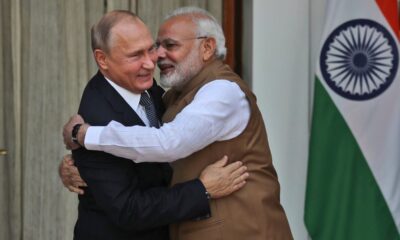Science
U.S. Military’s Space Operations Shift Amid Growing Orbital Threats

In a significant update to U.S. military operations in space, Colonel Raj Agrawal recently concluded a two-year command of Mission Delta 2, a unit responsible for tracking nearly 50,000 human-made objects in orbit. His leadership comes at a time of heightened concern over the potential for orbital warfare, particularly as tensions rise with major powers like China and Russia. The mission’s focus has shifted from merely cataloging objects in space to assessing whether these objects pose a military threat to U.S. forces.
During a visit to Peterson Space Force Base in Colorado, Agrawal shared insights into the evolving responsibilities of the U.S. Space Force, particularly in the context of growing international tensions. The unit he commanded plays a crucial role in fusing data from a network of sensors, identifying potential threats, and providing military commanders with a comprehensive operational picture of the space environment.
Transforming Space Operations
Agrawal’s tenure at Mission Delta 2 officially ended on July 3, 2023, as he prepares for his next role as the Space Force chair at the National Defense University. His path to this position is particularly noteworthy; before joining the military, Agrawal spent eight years as a schoolteacher in Texas, focusing on music and mathematics in a challenging urban environment. He credits his teaching background as a fundamental aspect of his leadership philosophy.
Agrawal’s career took a pivotal turn following the September 11 attacks. Initially selected for the Intercontinental Ballistic Missile (ICBM) career field, he soon transitioned to space operations, where he became an instructor in space situational awareness. His expertise was further sharpened during his time at the Pentagon, where he helped draft the inaugural budget for the newly established Space Force.
The nature of space operations has evolved dramatically since Agrawal first entered the field. The introduction of anti-satellite tests, notably China’s 2007 missile test that created thousands of pieces of debris, has fundamentally changed the landscape of space safety. The number of trackable objects has surged, complicating the mission of ensuring safe operations in low-Earth orbit.
Challenges of Space Domain Awareness
The U.S. military’s ability to monitor and manage space traffic has significantly improved. Modern radars and telescopes can track objects as small as a golf ball. Agrawal noted that the current mission involves not just preventing accidental collisions but also safeguarding against deliberate attacks on U.S. satellites. The Pentagon’s strategic posture reflects a recognition that space is now a contested domain.
Agrawal described the ongoing efforts of the Space Force to provide conjunction warnings to satellite operators, which offer crucial information about potential collisions. This responsibility was initially transferred to the Department of Commerce under the previous administration, but recent budget proposals indicate a potential retraction of that initiative, keeping these critical warnings under military oversight.
The conversation around space operations has also shifted to include the concept of Space Domain Awareness (SDA), which goes beyond traditional Space Situational Awareness (SSA). Agrawal explained that while SSA focuses on tracking objects, SDA incorporates an understanding of the intentions behind their movements, particularly regarding high-interest objects from adversarial nations.
The changing dynamics have led to concerns about the behavior of satellites operated by China and Russia. Agrawal highlighted specific examples of military capabilities disguised as scientific endeavors, which complicates the assessment of whether such activities are hostile or benign.
“Most of the time, we try to be nuanced in our analysis,” Agrawal stated. “But when behavior indicates a lack of coordination or poses a risk, we must consider it hostile.”
Despite the challenges, Agrawal emphasized the importance of cooperation with commercial entities like SpaceX, which shares orbital data to ensure safety in space operations. This collaboration is crucial not only for U.S. interests but also for maintaining a secure environment for all space users.
As the U.S. Space Force continues to adapt to the realities of an increasingly militarized space, Agrawal’s insights underscore the complexities and responsibilities of managing orbital traffic. The mission to ensure a safe and predictable space domain is more critical than ever, as nations navigate the delicate balance between cooperation and competition in the final frontier.
-

 Politics4 weeks ago
Politics4 weeks agoSecwepemc First Nation Seeks Aboriginal Title Over Kamloops Area
-

 World5 months ago
World5 months agoScientists Unearth Ancient Antarctic Ice to Unlock Climate Secrets
-

 Entertainment5 months ago
Entertainment5 months agoTrump and McCormick to Announce $70 Billion Energy Investments
-

 Science5 months ago
Science5 months agoFour Astronauts Return to Earth After International Space Station Mission
-

 Lifestyle5 months ago
Lifestyle5 months agoTransLink Launches Food Truck Program to Boost Revenue in Vancouver
-

 Technology3 months ago
Technology3 months agoApple Notes Enhances Functionality with Markdown Support in macOS 26
-

 Lifestyle3 months ago
Lifestyle3 months agoManitoba’s Burger Champion Shines Again Amid Dining Innovations
-

 Top Stories2 months ago
Top Stories2 months agoUrgent Update: Fatal Crash on Highway 99 Claims Life of Pitt Meadows Man
-

 Politics4 months ago
Politics4 months agoUkrainian Tennis Star Elina Svitolina Faces Death Threats Online
-

 Sports5 months ago
Sports5 months agoSearch Underway for Missing Hunter Amid Hokkaido Bear Emergency
-

 Politics5 months ago
Politics5 months agoCarney Engages First Nations Leaders at Development Law Summit
-

 Technology5 months ago
Technology5 months agoFrosthaven Launches Early Access on July 31, 2025





















